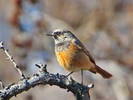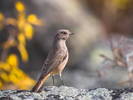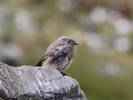search
classification
|
basic information
|
video
|
reports |
Black Redstart
Phoenicurus ochruros (S. G. Gmelin, 1774)

|
 male
|
|
|
2016-04-30
Altai Republic. Chui-Oozy village. |
© Vladimir Maer
|
|
Description
The Black Redstart is similar on Eurasian Redstart but distinguished from it by much of black in plumage. The male Black Redstart is distinguished from male Eurasian Redstart by the blackish-grey or black mantle and by much of black on underparts; the black color disperse to the breast's bottom; flanks and abdomen are orange (in European subspecies) or black (in Turkestan subspecies). The female doesn't have rufous color on the breast and flanks; it have brownish-grey color. The juveniles in first plumage are similar on female but have the well expressed dark borders on the upperparts. The juveniles are distinguished from the juveniles of Eurasian Redstart by the darker color and by the absent of light spots on upperparts. The tail on all plumages is red as on Eurasian Redstart. Weight 11-20 gr, length about 15, wing 7.8-8.5, wingspan 23-26 cm.
Biology
The Black Redstart is common, in places rare breeding migrant. It inhabits the dry rock slopes in the forest belt on 1400-2100 m in Altai and on the dry slopes with the meadow or bushes over the forest belt at 2700-2800 m in Western Tien Shan. It lives on the not hight attitudes only in Central Kazakhstan where the mountains are not higher than 2000 m. On migration it visits the low mountains, the riparian and saxaul forests, the reed-beds, the forest-belts, the groves and gardens. It appears in mid - end March, and in mid-April – early May in highlands. It breeds in separate pairs. The nest is built on the ground under the stone, in the cliff cracks, or in the constructions from the dry grass and is lined with the feathers. Clutches of white (sometimes blue tinged) 4-5 eggs is in mid-May - early July. Both parents feed juveniles fledged in mid-June – end July. Some pairs rear two broods per year. The autumn dispersal starts in August, majority of the birds migrate in September - early October, the latest migrants recorded in early November.
References
in other projects


















